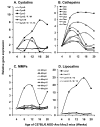Differential gene expressions in the lacrimal gland during development and onset of keratoconjunctivitis sicca in Sjögren's syndrome (SJS)-like disease of the C57BL/6.NOD-Aec1Aec2 mouse
- PMID: 19103199
- PMCID: PMC2699904
- DOI: 10.1016/j.exer.2008.10.006
Differential gene expressions in the lacrimal gland during development and onset of keratoconjunctivitis sicca in Sjögren's syndrome (SJS)-like disease of the C57BL/6.NOD-Aec1Aec2 mouse
Abstract
Recently, we reported development of the C57BL/6.NOD-Aec1Aec2 mouse carrying two genetic intervals derived from the NOD mouse. These two genetic regions confer Sjögren's syndrome (SjS)-like disease in SjS-non-susceptible C57BL/6 mice. In an attempt to define the molecular bases underlying onset of dacryoadenitis and subsequently keratoconjunctivitis sicca (or xerophthalmia) in the C57BL/6.NOD-Aec1Aec2 mouse model, we have carried out a study utilizing microarray technology. Using oligonucleotide microarrays, gene expression profiles of lacrimal glands at 4, 8, 12, 16 and 20weeks of age were generated for C57BL/6.NOD-Aec1Aec2 male mice. Analyses using Linear Models for Microarray Analysis package and B-statistics, 552 genes were identified as being differentially expressed (adjusted p-value <0.01 and B <1.5) during the development of SjS-like disease. These 552 genes could be arranged into four clusters, with each cluster defining a unique pattern of temporal expression, while the individual genes within each cluster could be grouped according to related function. Using a pair-wise analysis, temporal changes in gene expressions provided profiles indicating that individual genes were differentially expressed at specific time points during development of SjS. In addition, multiple genes that have been reported to show, either in humans or mouse models, an association with autoimmunity and/or SjS, e.g., ApoE, Baff, Clu, Ctla4, Fas/Fasl, Irf5, Lyzs, Nfkb, Socs3, Stat4, Tap2, Tgfbeta1, Tnfa, and Vcam1 were also found to exhibit differential expressions, both quantitatively and temporally. Selecting a few families of genes, e.g., cystatins, cathepsins, metalloproteinases, lipocalins, complement, kallikreins, carbonic anhydrases and tumor necrosis factors, it was noted that only a limited number of family members showed differential expressions, suggesting a restricted glandular expression. Utilizing these genes, pathways of inter-reactive genes have been constructed for apoptosis and fatty acid homeostasis, leading to modeling of possible underlying events inducing disease. Thus, these different approaches to analyze microarray data permit identification of multiple sets of genes of interest whose expressions and expression profiles may correlate with molecular mechanisms, signaling pathways and/or immunological processes involved in the development and onset of SjS in this mouse model, thereby providing new insight into the underlying cause or regulation of this disease.
Figures








Similar articles
-
Differential gene expression in the salivary gland during development and onset of xerostomia in Sjögren's syndrome-like disease of the C57BL/6.NOD-Aec1Aec2 mouse.Arthritis Res Ther. 2009;11(2):R56. doi: 10.1186/ar2676. Epub 2009 Apr 20. Arthritis Res Ther. 2009. PMID: 19379516 Free PMC article.
-
Early pathogenic events associated with Sjögren's syndrome (SjS)-like disease of the NOD mouse using microarray analysis.Lab Invest. 2006 Dec;86(12):1243-60. doi: 10.1038/labinvest.3700487. Epub 2006 Oct 30. Lab Invest. 2006. PMID: 17075579
-
Gene expression profiling of early-phase Sjögren's syndrome in C57BL/6.NOD-Aec1Aec2 mice identifies focal adhesion maturation associated with infiltrating leukocytes.Invest Ophthalmol Vis Sci. 2011 Jul 29;52(8):5647-55. doi: 10.1167/iovs.11-7652. Invest Ophthalmol Vis Sci. 2011. PMID: 21666236 Free PMC article.
-
Review of genes potentially related to hyposecretion in male non-obese diabetic (NOD) mice, a Sjögren's syndrome model.J Oral Biosci. 2023 Sep;65(3):211-217. doi: 10.1016/j.job.2023.05.001. Epub 2023 May 18. J Oral Biosci. 2023. PMID: 37209839 Review.
-
Abnormal Epigenetic Regulations in the Immunocytes of Sjögren's Syndrome Patients and Therapeutic Potentials.Cells. 2022 May 27;11(11):1767. doi: 10.3390/cells11111767. Cells. 2022. PMID: 35681462 Free PMC article. Review.
Cited by
-
Testosterone Influence on Gene Expression in Lacrimal Glands of Mouse Models of Sjögren Syndrome.Invest Ophthalmol Vis Sci. 2019 May 1;60(6):2181-2197. doi: 10.1167/iovs.19-26815. Invest Ophthalmol Vis Sci. 2019. PMID: 31108549 Free PMC article.
-
Upregulated Chemokine and Rho-GTPase Genes Define Immune Cell Emigration into Salivary Glands of Sjögren's Syndrome-Susceptible C57BL/6.NOD-Aec1Aec2 Mice.Int J Mol Sci. 2021 Jul 2;22(13):7176. doi: 10.3390/ijms22137176. Int J Mol Sci. 2021. PMID: 34281229 Free PMC article.
-
Periocular and intra-articular injection of canine adipose-derived mesenchymal stem cells: an in vivo imaging and migration study.J Ocul Pharmacol Ther. 2012 Jun;28(3):307-17. doi: 10.1089/jop.2011.0166. Epub 2011 Dec 16. J Ocul Pharmacol Ther. 2012. PMID: 22175793 Free PMC article.
-
Sjögren's syndrome: studying the disease in mice.Arthritis Res Ther. 2011 Jun 13;13(3):217. doi: 10.1186/ar3313. Arthritis Res Ther. 2011. PMID: 21672284 Free PMC article. Review.
-
Lymphotoxin-beta receptor blockade reduces CXCL13 in lacrimal glands and improves corneal integrity in the NOD model of Sjögren's syndrome.Arthritis Res Ther. 2011;13(6):R182. doi: 10.1186/ar3507. Epub 2011 Nov 1. Arthritis Res Ther. 2011. PMID: 22044682 Free PMC article.
References
-
- Benjamini Y, Hochberg Y. Controlling the false discovery rate: a practical and powerful approach to multiple testing. J R Statist Soc B. 1995;57:289–300.
-
- Bolstad AI, Wargelius A, Nakken B, Haga HJ, Jonsson R. Fas and Fas ligand gene polymorphisms in primary Sjögren's syndrome. J Rheumatol. 2000;27:2397–2405. - PubMed
-
- Botto M, Walport MJ. C1q, autoimmunity and apoptosis. Immunobiology. 2002;205:395–406. - PubMed
-
- Brayer J, Lowry J, Cha S, Robinson CP, Yamachika S, Peck AB, Humphreys-Beher MG. Alleles from chromosomes 1 and 3 of NOD mice combine to influence Sjögren's syndrome-like autoimmune exocrinopathy. J Rheumatol. 2000;27:1896–1904. - PubMed
-
- Cha S, Nagashima H, Brown VB, Peck AB, Humphreys-Beher MG. Two NOD Idd-associated intervals contribute synergistically to the development of autoimmune exocrinopathy (Sjögren's syndrome) on a healthy murine background. Arthritis Rheum. 2002a;46:1390–1398. - PubMed
Publication types
MeSH terms
Grants and funding
LinkOut - more resources
Full Text Sources
Other Literature Sources
Medical
Molecular Biology Databases
Research Materials
Miscellaneous

